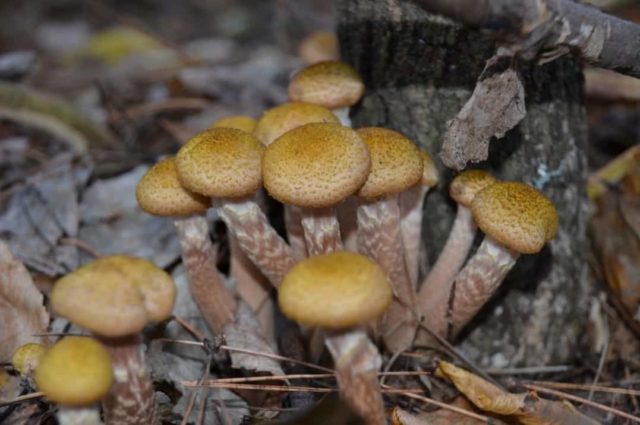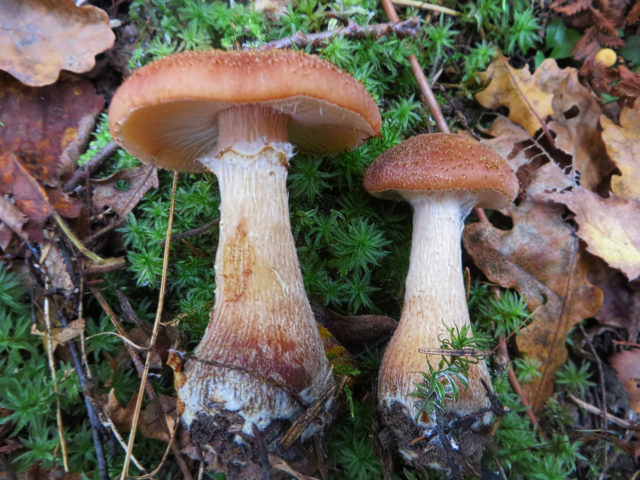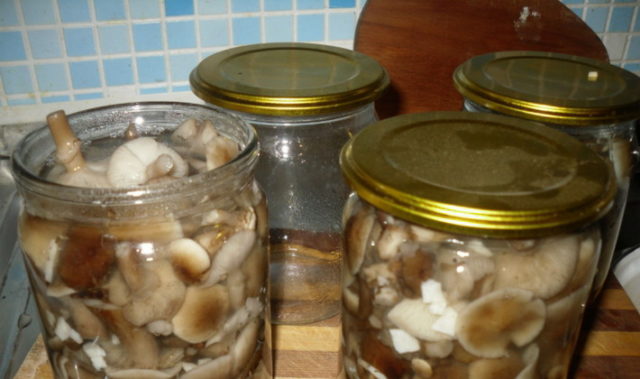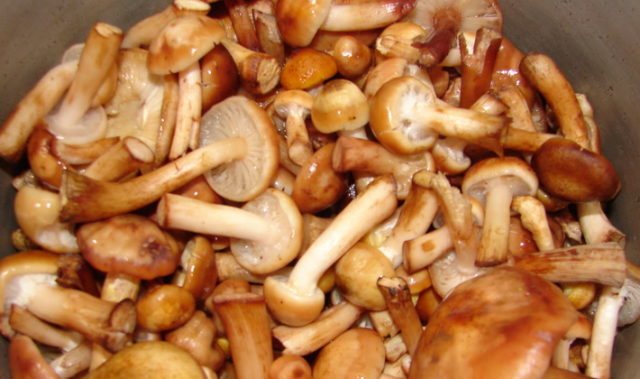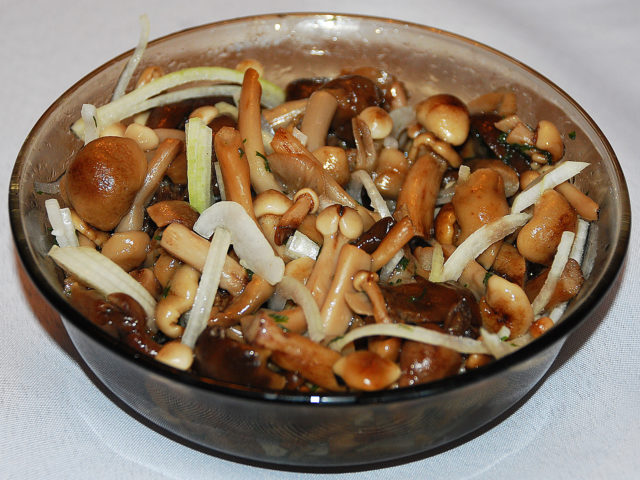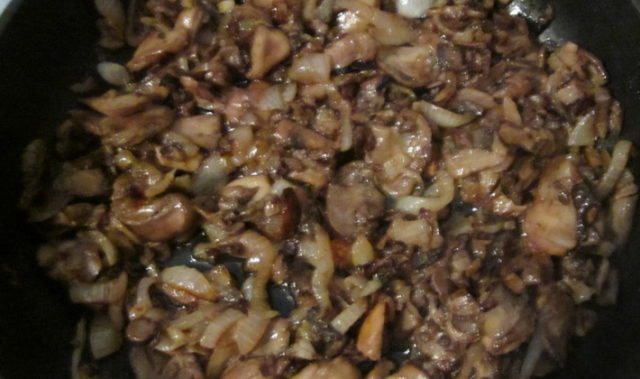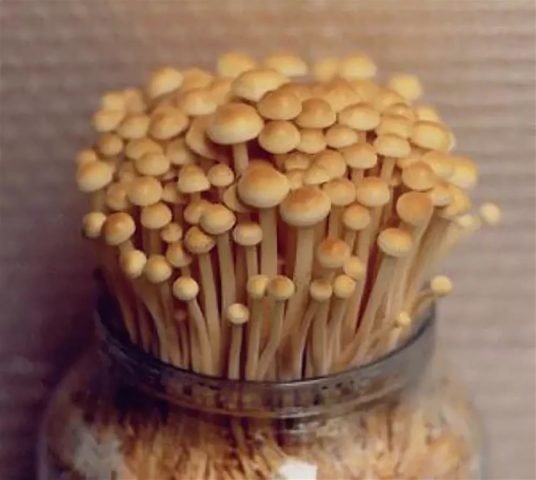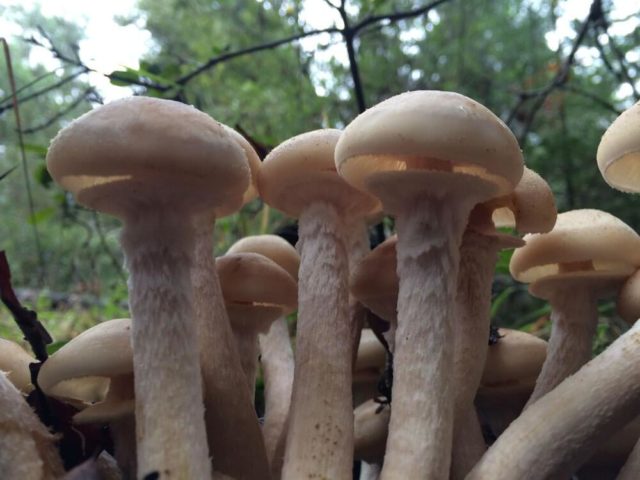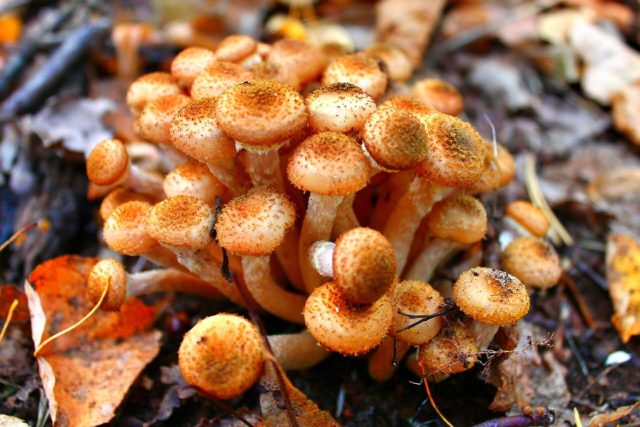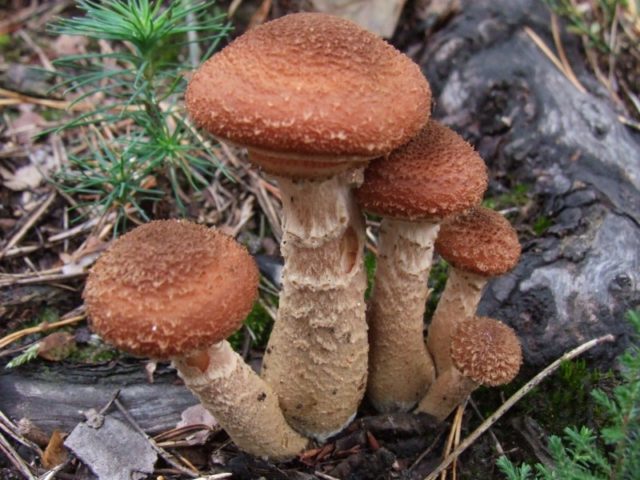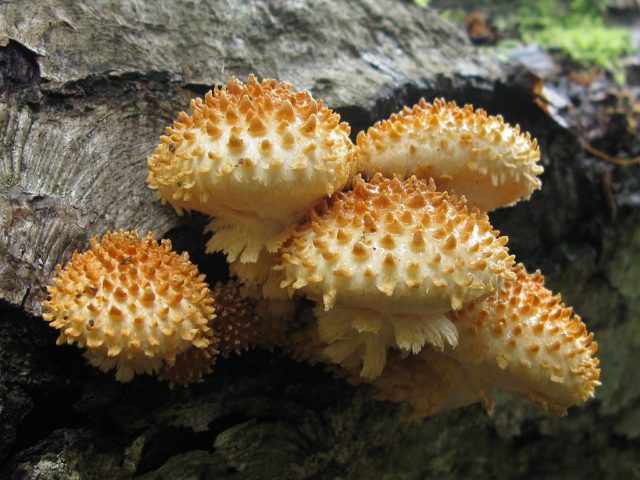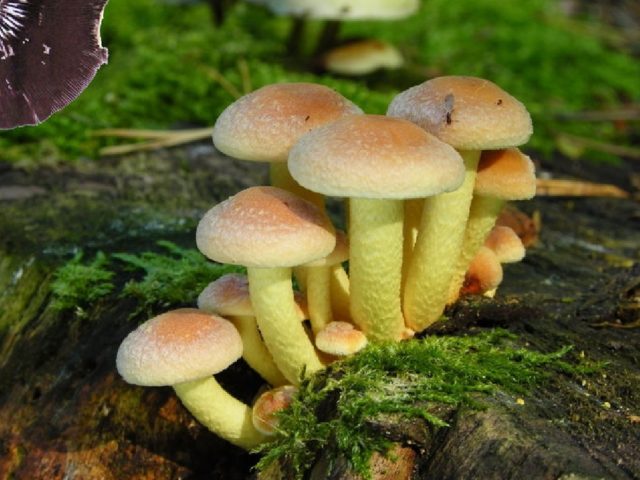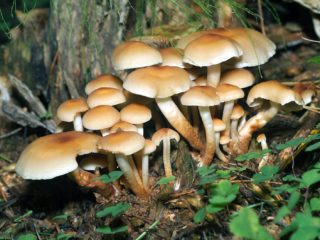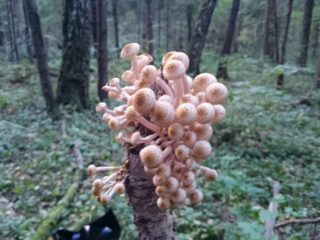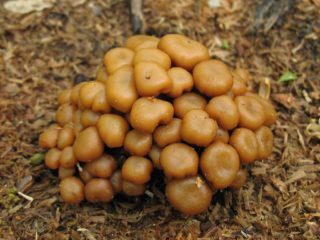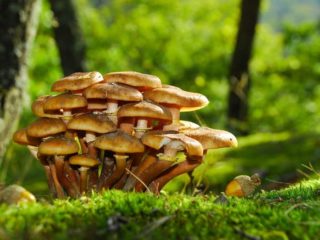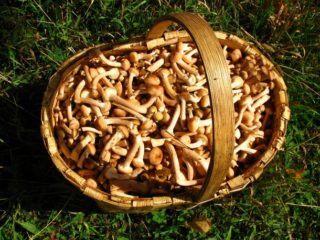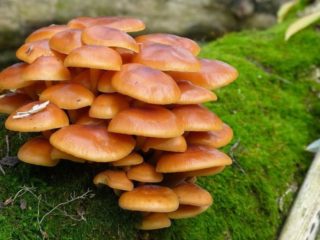Content
- 1 Do honey mushrooms have thick stems?
- 2 What does the thick-legged honey fungus look like?
- 3 Is the edible honey mushroom thick-legged or not?
- 4 How to cook thick-legged mushrooms
- 5 Medicinal properties of honey mushrooms with a thick stem
- 6 Where and how does it grow
- 7 Growing autumn thick-legged honey mushrooms at home
- 8 Doubles and their differences
- 9 Interesting facts about thick-legged honey mushrooms
- 10 Conclusion
Thick-legged honey fungus is a mushroom that has an interesting history.You can cook a lot of dishes with it, which is why it often ends up in baskets. The main thing is to be able to distinguish it from similar species.
Do honey mushrooms have thick stems?
Forest mushrooms with a thick stem are not uncommon, so every mushroom picker should know what they look like. The species belongs to the genus Honey fungus, family Physalacriaceae. The mushroom has other names - bulbous or Armillaria cylindrical. Previously, it was also called autumn, but later scientists came to the conclusion that these are two different species.
What does the thick-legged honey fungus look like?
It has a number of features; upon careful examination, it is easy to distinguish it from other species. Below is a photo and description of the thick-legged honey mushroom:
Description of the cap
The cap reaches 10 cm in diameter. In young specimens it is dome-shaped, but then opens almost completely, the edges becoming slightly drooping. The cap has scales radiating from the center. They darken near the old fruiting bodies, descending onto the stem. The color can vary, brown, pinkish, brown and grayish are found.
The pulp is light and smells like cheese. A white spore powder is formed. The honey mushroom cap on a thick stem is visible in the photo:
Description of the leg
The leg grows up to 8 cm, reaching a girth of 2 cm. Its shape resembles a cylinder, expanding downward. The flesh of the leg is fibrous and elastic.
Is the edible honey mushroom thick-legged or not?
Thick-legged honey fungus is classified as an edible mushroom. But before eating it, it must be cooked thoroughly to remove the bitterness. In its raw form it has a peculiar acrid taste.
How to cook thick-legged mushrooms
Mushrooms are processed almost immediately after collection. First of all, remove forest debris - stuck leaves, needles, twigs, soil. Then rinse well.Before preparing any dish from them, the mushrooms are boiled to get rid of the bitterness. To do this, for 1 kg of honey mushrooms you will need 2 liters of clean water and 1.5 tbsp. l. salt.
All ingredients, except the mushrooms themselves, are mixed in a deep saucepan and brought to a boil. Then pour honey mushrooms there, reduce the heat and leave to cook for 15-20 minutes. Place the finished mushrooms in a colander to get rid of excess water. They will cool down and be suitable for frying, stewing, and salting.
How to quickly marinate thick-legged mushrooms
There is a quick pickling method for these mushrooms.
The following ingredients are needed:
- 500 g mushrooms;
- 500 ml water;
- 50 ml table vinegar;
- 100 ml vegetable oil;
- 3-4 garlic cloves;
- 2 tsp. granulated sugar;
- 1 tsp. salt;
- 2-3 pcs. bay leaf;
- 1 tsp. mustard beans;
- black peppercorns according to your taste.
Honey mushrooms need to be washed well and start preparing the marinade. The ingredients are mixed in a container, brought to a boil and only then the mushrooms are added. Leave on fire for 5-10 minutes. Then the honey mushrooms in the marinade are put into jars and put in the refrigerator for at least 4-5 hours.
Marinating thick-legged honey mushrooms using the hot method
In order to marinate mushrooms, you will need the following ingredients:
- 1 kg of mushrooms;
- 2 tbsp. l. table salt;
- 1 tbsp. l. Sahara;
- 1 tbsp. l. vinegar;
- 2 clove buds;
- 1 bay leaf;
- 5 pieces. peppercorns.
Peel the mushrooms, rinse and boil for 10-15 minutes. Add salt and spices to a container with water, pour in vinegar after the liquid has boiled. Then immediately add the mushrooms. Keep the pan on low heat for 20 minutes.The product processed in this way is placed in jars, but not closed, but placed in a pan and sterilized for 25-30 minutes. At the final stage, the workpieces are closed and stored in a cool place. It is necessary to ensure that the sun's rays do not fall on the jars.
Hot salting of autumn thick-legged mushrooms
Thick-legged mushrooms are not only pickled, but also salted. They are equally tasty in all cooking options. With the hot method, the mushrooms are boiled and then pickled. Required Products:
- 1 kg thick-legged mushrooms;
- 3 tbsp. l. salt;
- 3-4 stalks of dill;
- 3 bay leaves;
- 3 pcs. clove buds;
- peppercorns 6 pcs.
After the boiled mushrooms have cooled, several layers of spices and honey mushrooms are formed in the container. There must be salt on top. The resulting mass is covered with a clean cloth, a plate is placed and a weight is placed on it. The container should be kept cool, the fabric should be changed periodically so that it does not become sour from the brine released. The dish will be ready in 25-30 days.
How to dry honey mushrooms for the winter
Thick-legged honey mushrooms are suitable for drying for the winter, but they do not need to be washed and boiled. It is enough to clear away debris well. Whole young specimens are taken and, if there are wormholes, discarded. You can dry it in the sun or in the oven. They are usually strung on a thread. The optimal oven temperature for drying is 50 °C.
In the oven, you need to periodically turn the baking sheet. When they reach the desired state, they are put into jars and put in a dry place. It is important to remember that mushrooms can absorb odors, so they should be stored in a room with fresh air.Before you cook anything from a dried product, it is first soaked.
How to fry thick-legged mushrooms with onions
Honey mushrooms fried with onions are a common dish. For it you will need:
- 300 g onions;
- 1 kg of mushrooms;
- 2 tbsp. l. vegetable oil;
- salt pepper.
Rinse the honey mushrooms well first and then boil them. Meanwhile, prepare the onion - cut it into half rings and fry it in a frying pan, adding oil. As soon as the pieces become transparent, mushrooms are added to them. When the honey mushrooms are ready, they will acquire a golden color.
Medicinal properties of honey mushrooms with a thick stem
The honey fungus is not only edible, but also helps in the treatment of certain diseases. It contains vitamins A and B, polysaccharides, potassium, zinc, iron, copper, magnesium. Has the following healing effects:
- reduces high blood pressure;
- normalizes the functioning of the gastrointestinal tract;
- increases resistance to acute respiratory infections.
There are also contraindications:
- children under 3 years of age;
- period of pregnancy and lactation;
- acute phase of gastrointestinal diseases.
Where and how does it grow
The species prefers rotten stumps, trunks of fallen trees, and rotting leaves. Most often it can be seen on beech and spruce, less often found on ash and fir. A large harvest is harvested in a temperate climate, but it is also found in the southern regions, also in the Urals and the Far East. It grows in groups and appears from August to mid-November.
Growing autumn thick-legged honey mushrooms at home
Honey mushrooms with a thick stem can also be grown at home. But we need to take into account some nuances - the fungus is a wood-destroying species. Mycelium is purchased in specialized stores.
Mushrooms are grown in two ways:
- On a rotten tree - the method is simple, it can be used even in an apartment. The substrate is placed in a container and filled with boiling water. Hay, straw or sawdust will do. When the mixture has cooled, strain it, squeeze out excess moisture and mix the substrate with the mycelium. Each manufacturer indicates the exact proportions on the packaging. The resulting composition is placed in a plastic bag, tied and slits are made on the surface. For germination, it is placed in a convenient place or simply hung. No lighting is required, you need to wait about a month for germination. But when the primordia of fruiting bodies appear, the bag must be removed from the dark. More cuts are made on the film at the sites of germination. Fruiting lasts up to 3 weeks, but the largest harvest is harvested in the first two.
- On rotten plant remains - this option is more complicated, but longer-term in terms of harvesting period. The bars, 35 cm long and 20 cm in diameter, are soaked for a week. Then holes are drilled in the tree and the mycelium is placed there. The top is secured with tape and covered with paper, straw or cotton wool. The mycelium will germinate within 6 months. The bars should be kept in a cool room at this time. The temperature at which the mycelium survives ranges from + 7 °C to + 27 °C. The harvest is obtained up to 3 times a year.
Young mushrooms with thick legs are shown in the photo:
Doubles and their differences
The thick-legged honey mushroom has doubles with which inexperienced mushroom pickers can easily confuse it. Some are edible, some are poisonous. These include:
- Autumn honey fungus — the cap in adult specimens reaches 15 cm in diameter, and the color of soft tones ranges from gray-yellow to yellow-brown. The pulp has a pleasant taste and smell. Unlike the thick-legged honey agaric, this species is found on both living and rotten wood. Edible, but there is debate about its taste, and in Western countries it is generally considered a low-value species from the point of view of consumption. Autumn thick-legged honey mushrooms are shown in the photo:
- Dark honey fungus - a similar species, but differs in that the ring on its leg breaks unevenly, while in the thick-legged one it is star-shaped. Also, the smell of this type does not resemble cheese, it is quite pleasant. The scales disappear from the surface of the cap as they grow. Is edible. Honey mushrooms on a thick stalk are brownish-gray, which can be seen in the photo
- Hairy scale — there are a lot of scales on its cap, spores of an ocher hue. The stem of the mushroom is long and quite thin, tapering downwards. It has a pungent odor and an unpleasant bitter taste. It is considered conditionally edible.
- False honey fungus sulfur-yellow - The cap is yellow and has a brown tint. The plates are greyish. The leg is light yellow in color, hollow inside, thin. The taste is bitter, the smell is unpleasant. The mushroom is poisonous.
Interesting facts about thick-legged honey mushrooms
In the state of Michigan in the 90s of the last century, an oak forest was discovered that was completely inhabited by thick-legged honey mushrooms. The trees were cut down and after a while pine trees were planted in their place. But the young seedlings were almost immediately affected by thick-legged honey mushrooms and were unable to develop further.
After the soil in the forest was examined, it was discovered that it contained mycelium, the total area of which was 15 hectares. Its mass is approximately 10 tons, and its age is about 1500 years.DNA analysis of individual fruiting bodies was carried out, and it turned out that this is one giant organism. Thus, it can be argued that Michigan is home to the largest single living organism of the entire existence of the Earth. After this discovery, the species became widely known.
Conclusion
The thick-legged honey fungus is an edible mushroom, which is also very convenient to collect during the season; it grows in large groups. For those who do not like to walk in the forest, there is an option to grow it right in the apartment. It is good with any method of preparation. You can see what the thick-legged honey mushroom looks like in the video:
